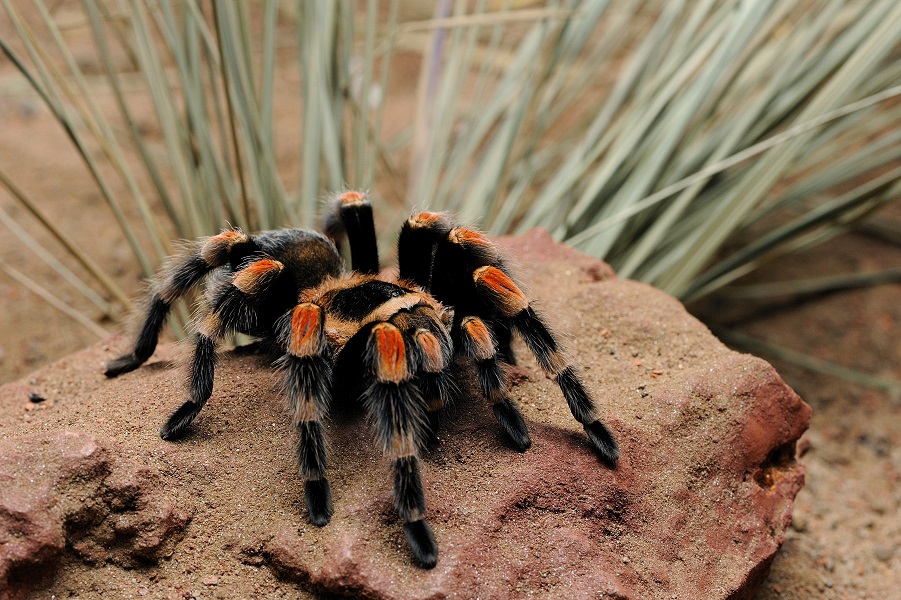
The Mexican Red Knee Tarantula:
In the world of tarantula keeping, the Mexican Red Knee Tarantula (Brachypelma hamorii) is iconically known for its striking appearance and generally calm behavior. Though, it is fair to say, as with all tarantulas, their temperaments can be very varied; we have encountered docile palm pet red knees, as well as highly defensive, too.
Habitat and Range:

The Mexican Red Knee Tarantula is indigenous to the arid and semi-arid regions of western Mexico, primarily found along the Pacific coast. Its natural habitat spans from the states of Colima and Michoacán to the southern reaches of Baja California. These areas are characterized by scrublands, deserts, and thorn forests, where the tarantula has adapted to the challenging environmental conditions.
Appearance
One of the most distinguishing features of the Mexican Red Knee Tarantula is its stunning appearance. It boasts a black body adorned with vibrant red-orange bands on its knees, giving it its iconic name. The overall effect is a striking contrast that makes this species easily recognizable among tarantula enthusiasts. Adult females (seen on the right) are typically larger, with a leg span of 5 to 6 inches, while males (seen on the left) are smaller and more slender.

Behavior
Despite its striking appearance, the Mexican Red Knee Tarantula is generally docile and slow-moving, making it a popular choice for novice tarantula keepers. These tarantulas are primarily terrestrial, spending most of their time on the ground. They are solitary creatures and are known for their burrowing behavior, creating intricate underground dens to call home.
The Art of Husbandry
Enclosure
Creating a suitable habitat for your Mexican Red Knee Tarantula is crucial for its well-being. A glass or plastic terrarium is an ideal enclosure, as it provides visibility and maintains humidity. A 10 to 20-gallon tank is usually sufficient, although larger enclosures can be beneficial for more active tarantulas. Ensure adequate ventilation while minimizing any potential escape routes.
Substrate
A substrate that mimics their natural environment is essential. A combination of coconut coir, peat moss, and vermiculite is often used. This mixture retains moisture and provides a burrowing medium for your tarantula. Depth is crucial, as these tarantulas enjoy digging, so provide at least several inches of substrate.
Temperature and Humidity
Maintaining the right environmental conditions is crucial. Mexican Red Knee Tarantulas thrive at temperatures between 75-85°F (24-29°C) during the day, with a slight drop at night. Humidity levels should be kept between 65-75%, achieved through periodic misting and a water dish. A hygrometer and thermometer are essential tools to monitor these conditions.
Feeding
Feeding your tarantula is relatively simple. They are carnivorous and typically consume insects such as crickets, roaches, and mealworms. Offer appropriately-sized prey every 1-2 weeks, adjusting the size to match your tarantula’s abdomen. Remove uneaten prey to prevent stress or injury. This is particularly important if you red knee is entering its moult phase. As with all pet tarantulas, never offer live food at this stage. You can find more information on this in the introduction to tarantula keeping post.
Handling
While Mexican Red Knee Tarantulas are generally docile, handling should be limited and done with care. They have urticating hairs on their abdomen that can be irritating to the skin and eyes. Frequent handling can also stress them, so it’s best to observe their beauty from outside the enclosure.
Lifespan
With proper care, Mexican Red Knee Tarantulas can live for 20 – 30 years or more. Males typically have a shorter lifespan of 5-7 years, while females can live considerably longer.
Conclusion
The Mexican Red Knee Tarantula is a mesmerizing arachnid species that provides both beauty and intrigue to those who choose to care for them. With its captivating appearance and manageable husbandry requirements, it’s no wonder these tarantulas have become a favorite among enthusiasts. As with any pet, responsible ownership is essential, and those who venture into the world of tarantula keeping are rewarded with a glimpse into the mysteries of the arachnid kingdom. So, whether you’re an experienced tarantula keeper or a curious beginner, the Mexican Red Knee Tarantula awaits, ready to share its unique charm and captivating presence.